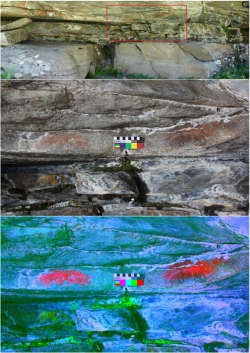
The production of rock art involves a series of 'choices' regarding location, materials, and images produced. In most landscapes, there are many properties or features that would have influenced the choice of location (with some arguing that even acoustic characteristics were important (Díaz-Andreu and Benito 2012; Díaz-Andreu
In some landscapes, there is evidence that orientation of the site was important. For example, in Lower Provence 80% of sites with prehistoric paintings are orientated between the south-east and south-west (generally in a southerly direction), while the Abri Faravel is orientated towards the east. If there were an accepted convention regarding orientation, it was clearly impossible to observe this convention everywhere. However, as some suggest, the ostensible preference for uninhabited areas for rock art production in Lower Provence (Hameau 1989, 67-8) is one criteria that could be fulfilled at Faravel. The choice of the Abri Faravel in Ecrins is in fact interesting, as there are so few suitable rock surfaces available – it is of course possible that more rock art was produced in the area, but the fragile lithology has inhibited preservation.

One of the unusual characteristics of the Abri Faravel is that most of the paintings are on the ceiling – only visible if you happen to look up once you are beneath the rock overhang. It is likely that only the six painted marks on the bottom wall of the shelter would have been visible from the exterior (Figure 14). The combination of the remote situation of the rock shelter, and the position of the painting might allow us to suggest that there was a level of exclusivity associated with this site (Bahn 2010, 152-3). However, this notion of exclusivity has to be tempered by the fact that the plateau was clearly attractive, and used by both hunters and pastoralists over the millennia.